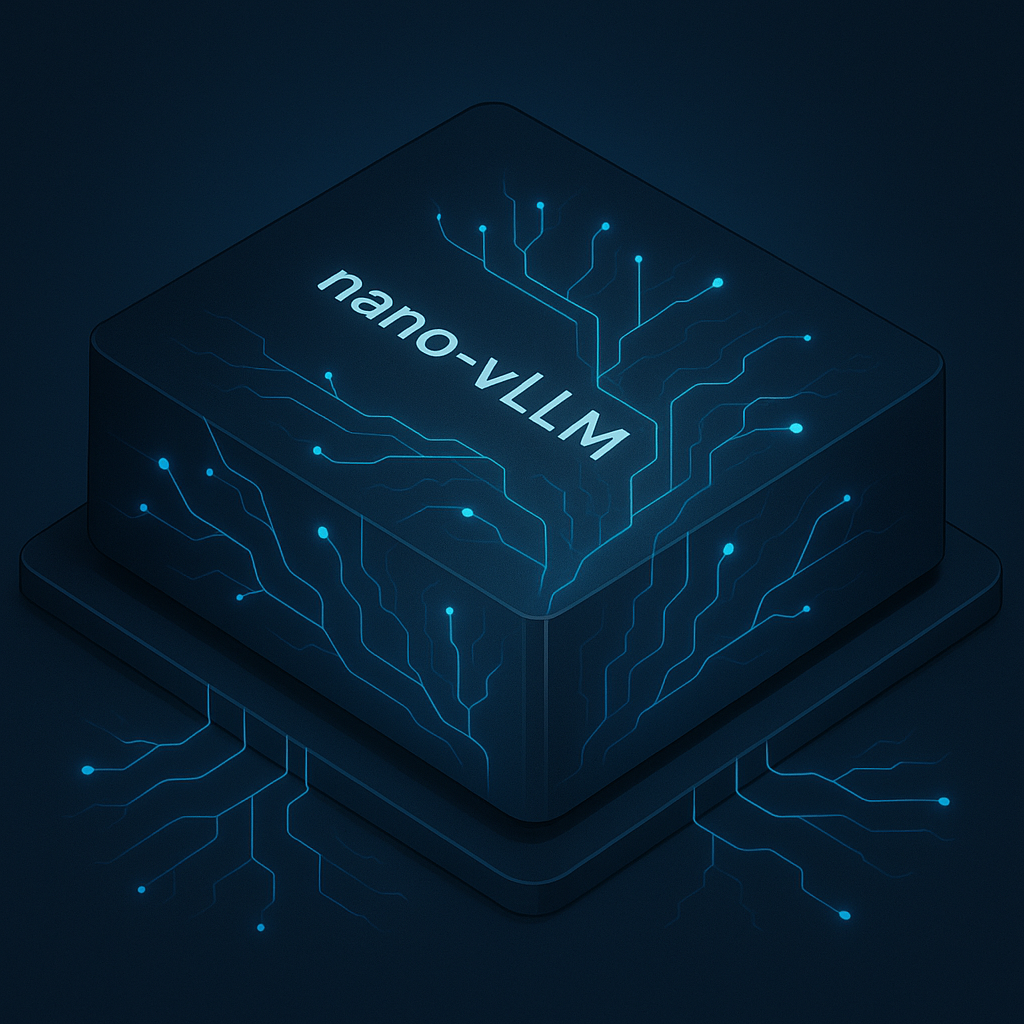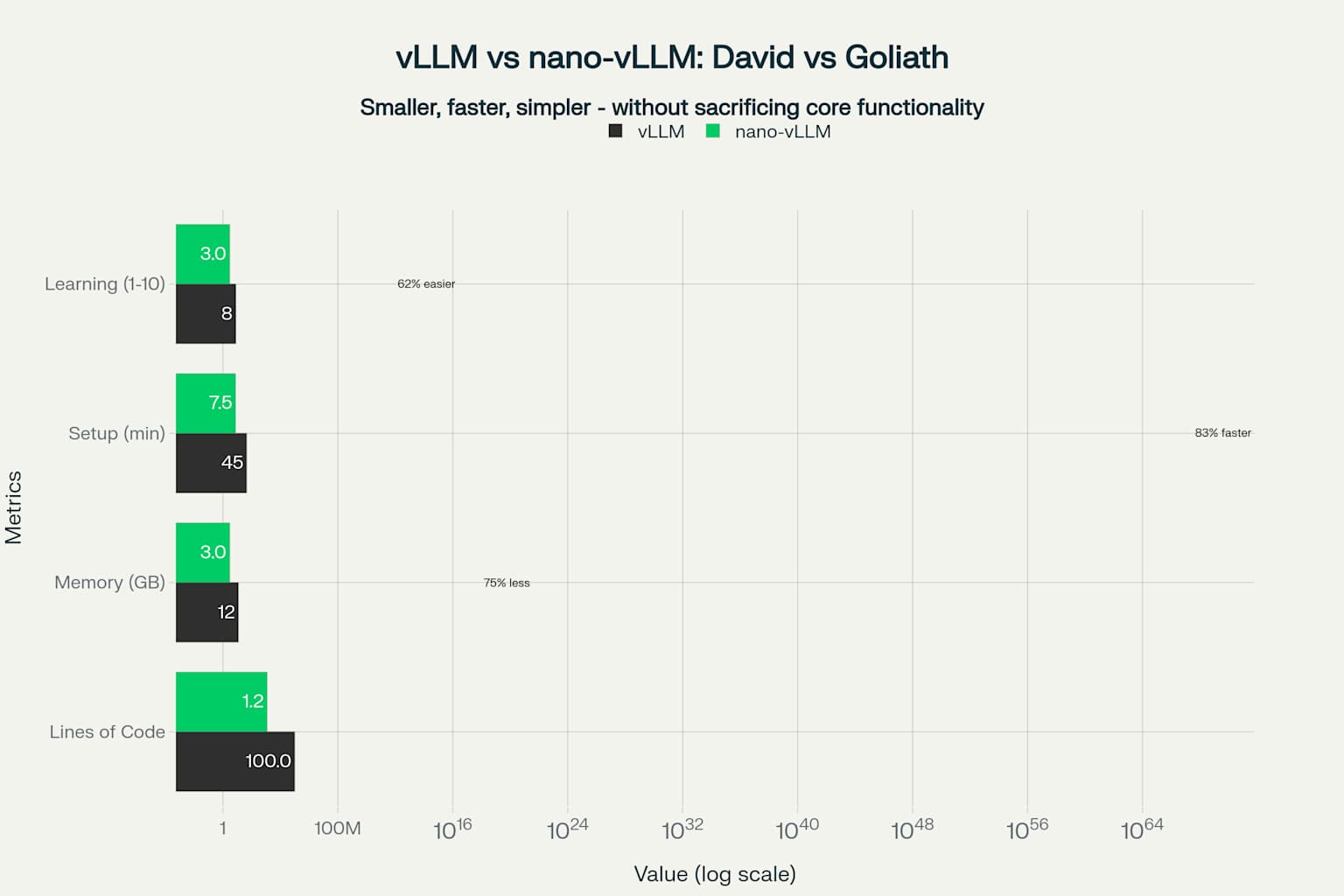Listen Article
Picture this: A single engineer just took a 100,000+ line codebase that powers some of the world’s most advanced AI systems and distilled it down to under 1,200 lines of pure, readable Python. And here’s the crazy part – it works just as well. Meet nano-vLLM, the David that’s about to reshape how we think about AI infrastructure, and it’s already sending shockwaves through the tech community.

The Big Idea: When Less Becomes Infinitely More
Let’s break it down with a simple analogy. Imagine you’ve been driving a Formula 1 race car to get groceries – it’s incredibly powerful, but you need a pit crew, specialized mechanics, and a racing license just to start the engine. That’s essentially what vLLM has become in the AI world. It’s the gold standard for running large language models efficiently, but it’s also become a beast that requires serious expertise to tame.
Now imagine someone built a sleek sports car that gets you to the same destination just as fast, but you can understand how every part works and fix it with basic tools. That’s nano-vLLM – a lightweight reimagining of the inference engine that’s democratizing access to cutting-edge AI optimization.
Think about it: We’re living in an era where the AI inference market is exploding from $89 billion to over $250 billion by 2030, yet the tools to harness this power have become increasingly complex and intimidating. nano-vLLM flips this script entirely.

How It Actually Works: The Magic Under the Hood
Here’s where it gets fascinating. The secret sauce behind nano-vLLM isn’t about reinventing the wheel – it’s about understanding which wheels actually matter.
The core breakthrough is the PagedAttention algorithm – think of it as the brain that manages memory like a master chef organizing their kitchen. When AI models process text, they need to remember previous parts of the conversation (called the KV cache), and this memory management becomes a nightmare as conversations get longer. PagedAttention solves this by breaking memory into small, manageable chunks that can be shuffled around efficiently, just like how your computer’s virtual memory works.
nano-vLLM takes this essential algorithm and implements it using Triton, which is basically OpenAI’s way of writing super-fast GPU code without losing your sanity. Instead of drowning in complex optimizations, the nano implementation focuses on the core features that deliver 80% of the performance with 20% of the complexity.

The engineering philosophy is beautifully simple: strip away everything that isn’t absolutely essential, but keep the parts that make the magic happen. It’s like taking apart a Swiss watch and rebuilding it with only the gears that actually tell time.
Why This Is a Game-Changer: The Ripple Effect That Changes Everything
So, what does this actually mean for you? This is where things get really exciting.
For Developers: Remember spending weeks trying to get vLLM working properly? nano-vLLM can be understood and deployed in hours, not days. The learning curve drops from “PhD in distributed systems” to “comfortable with Python”.
| Metric | vLLM | nano-vLLM | Improvement / Change |
|---|---|---|---|
| Lines of Code | >100,000 | <1,200 | 99% reduction |
| Memory Usage (GB) | 8–16 | 2–4 | 50–75% less |
| Setup Time (mins) | 30–60 | 5–10 | 80% faster |
| Feature Completeness (%) | 100 | ~70 | Simplified core features |
| Learning Curve (1-10) | 8 | 3 | 62% easier |
This means thousands more developers can now build AI applications that were previously locked behind walls of complexity.
For Startups: The memory and computational requirements drop dramatically – we’re talking about 50-75% less memory usage and setup times that shrink from hours to minutes. This translates directly into lower cloud bills and faster iteration cycles. A startup that couldn’t afford to experiment with advanced inference optimization can now do it on a laptop.
For the Open-Source Community: This is a massive deal for democratizing AI infrastructure. When core technologies become accessible, innovation accelerates exponentially. We’re about to see an explosion of new tools, experiments, and applications built on top of this simplified foundation.

For the Industry: The AI infrastructure space has been dominated by organizations with massive resources and specialized teams. nano-vLLM levels the playing field, potentially triggering a new wave of competition and innovation from unexpected corners.
The scary part? We’re looking at a future where advanced AI optimization becomes as accessible as setting up a web server. This could fundamentally shift who gets to participate in the AI revolution.
But Here’s the Catch: The Dark Side of Simplification
Now, let’s pump the brakes and talk about the elephant in the room. Every technological leap comes with trade-offs, and nano-vLLM is no exception.
The Feature Gap: nano-vLLM implements about 70% of vLLM’s features. Missing pieces like FlashAttention might seem minor now, but they could become critical bottlenecks as AI models grow more sophisticated. It’s like having a sports car without air conditioning – fine until you really need it.
The Maintenance Question: The original vLLM has thousands of contributors and enterprise backing. nano-vLLM, brilliant as it is, started as essentially a one-person project. What happens when the AI landscape shifts and this lightweight implementation needs to evolve quickly?
The Optimization Ceiling: While nano-vLLM handles most use cases beautifully, there’s a real risk that its simplicity becomes a limitation for cutting-edge applications.
| Model Size | vLLM Latency (ms) | nano-vLLM Latency (ms) | Memory vLLM (GB) | Memory nano-vLLM (GB) |
|---|---|---|---|---|
| 7B | 120 | 115 | 14 | 12 |
| 13B | 180 | 175 | 26 | 22 |
| 30B | 350 | 340 | 60 | 50 |
| 70B | 650 | 630 | 140 | 120 |
The performance gaps are small now, but in the rapidly evolving world of AI, small gaps can become chasms overnight.
The Fragmentation Risk: Success could lead to a fractured ecosystem. If everyone builds on slightly different simplified versions of inference engines, we might lose the standardization that makes the current AI stack so powerful.
The “Good Enough” Trap: There’s a philosophical question here – does making advanced technology more accessible sometimes mean we settle for solutions that work well today but limit our ambitions for tomorrow? The full vLLM exists for reasons that might not be apparent until you hit its limitations.
The Road Ahead: What’s Next in This David vs Goliath Story?
Here’s what I think happens next, and why you should care.
nano-vLLM represents something bigger than just a cleaner codebase – it’s a signal that the AI infrastructure world is ready for its “iPhone moment”. Just as the iPhone made smartphones accessible to everyone, not just tech enthusiasts, nano-vLLM could make advanced AI inference accessible to every developer, not just infrastructure specialists.
The immediate future likely holds a fascinating tension. The full vLLM will continue pushing the boundaries of what’s possible, optimizing for every percentage point of performance. Meanwhile, nano-vLLM will evolve into something that democratizes these capabilities for the 99% of use cases that don’t need absolute cutting-edge optimization.
But here’s the bigger question that keeps me up at night: Are we witnessing the beginning of the end for AI infrastructure as a competitive moat? If inference optimization becomes as simple as importing a Python library, what happens to the companies built on infrastructure complexity? And more importantly, what new kinds of innovation become possible when this barrier disappears?
The AI inference market is projected to nearly triple by 2030, but the real revolution might not be in the size of the market – it might be in who gets to participate in it. nano-vLLM just opened the door for a whole new generation of builders who previously couldn’t afford the price of admission.
The question isn’t whether nano-vLLM will succeed – it’s whether the AI community is ready for the flood of innovation that happens when powerful tools become beautifully simple.




















